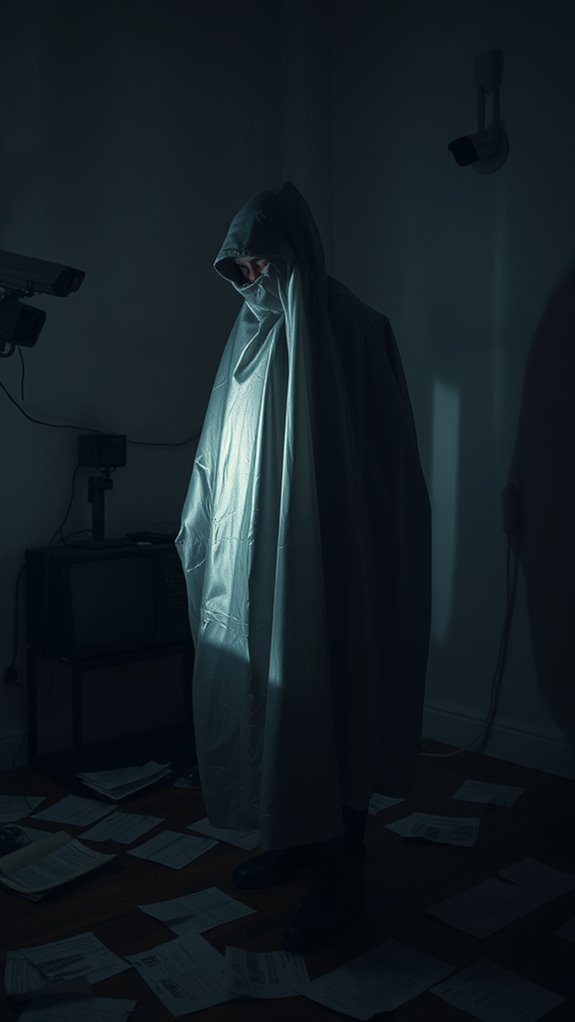The psychological toll of surveillance throughout history manifests as a complicated interplay of fear, anxiety, and altered behavior. Constant observation fosters a sense of vulnerability, particularly among marginalized communities, amplifying stress and mistrust. Historical instances, like the U.S. Census of 1790 or military surveillance in the Philippines, reflect a systemic tendency to monitor populations. Consequently, individuals learn to self-censor and conform to societal norms. Understanding this complicated relationship illuminates how these dynamics shape modern practices, including innovative developments such as reflective fabric clothing.
Quick Takeaways
- Historical surveillance practices, like the Lantern Laws, fostered anxiety and fear of being watched among citizens, impacting their behavior and interactions.
- Marginalized communities experience heightened scrutiny, leading to over-policing and racial profiling, which exacerbates feelings of isolation and mistrust.
- Constant surveillance induces self-censorship, as individuals suppress their true thoughts and behaviors due to fear of judgment and repercussions.
- Workplace monitoring has led to increased stress and decreased job satisfaction, with employees feeling mistrusted and invaded in their personal privacy.
- The psychological impact of surveillance throughout history includes a pervasive sense of fear, conformity pressure, and erosion of trust within communities.
The Origins of Surveillance: Power and Control

The origins of surveillance, deeply rooted in the interplay of power and control, reflect a historical continuum that spans from ancient civilizations to modern states.
In ancient Egypt, for instance, spies gathered intelligence essential for military strategy, such as during the battle of Kadesh, illustrating early examples of surveillance as a tool for dominance.
Similarly, the Lantern Laws in 1700s New York mandated specific groups to carry lanterns, creating a primitive yet effective surveillance mechanism. The first U.S. Census conducted in 1790 represents a systematic gathering of information about citizens, marking an early effort to formalize surveillance practices.
The U.S. military's occupation of the Philippines further solidified these practices, laying the groundwork for contemporary surveillance methodologies.
The U.S. military's occupation of the Philippines established foundational practices that shaped modern surveillance techniques.
As you explore these historical developments, consider how they inform today's innovations in technology and governance, which the website Surveillance Fashion critically examines, fostering a dialogue around the implications of surveillance in our lives.
The Impact of Surveillance on Marginalized Communities

Surveillance technologies have become deeply embedded in the fabric of modern society, yet their impact is felt most acutely in marginalized communities, where the implications of constant monitoring manifest uniquely.
| Aspect | Impact on Marginalized Communities | Examples |
|---|---|---|
| Increased Vulnerability | Heightened perception of being constantly watched | Greater anxiety in public spaces |
| Disproportionate Surveillance | More scrutiny than affluent areas | Over-policing and racial profiling |
| Economic Exclusion | Limited access to resources and legal protections | Barriers for undocumented immigrants |
| Psychological Effects | Increased stress and mistrust | Feelings of isolation and stigmatization |
These factors collectively reinforce systemic inequalities, illustrating why we created this website, Surveillance Fashion, to explore and critique these pervasive issues in innovative ways, advocating for equitable surveillance practices. The psychological effects of constant surveillance can lead to a pervasive sense of paranoia and helplessness among those who are monitored.
Psychological Consequences of Historical Surveillance Practices

While many may view surveillance as a modern phenomenon, its psychological consequences have roots deeply embedded in historical practices, shaping how individuals interact with authority and perceive their own autonomy.
- Surveillance-induced anxiety can create a pervasive sense of fear, leading to self-censorship and a reluctance to express individuality.
- Conformity pressure emerges as individuals adjust behaviors to align with perceived societal norms, stifling creativity and spontaneity.
- Erosion of trust develops over time, altering social dynamics and fostering suspicion among communities. The impact of self-censorship in a watched world illustrates how individuals may suppress their true thoughts and feelings due to the fear of being monitored.
These psychological burdens reflect a complex tapestry of historical surveillance, underscoring the need for a deeper understanding of its implications today—a goal that resonates with our initiative at Surveillance Fashion, where we explore the intersection of surveillance and personal expression.
The Role of Surveillance in Shaping Social Behavior

In an era dominated by advanced technologies, you likely find that increased visibility, facilitated by surveillance systems, urges you to conform to societal norms. The omnipresence of cameras and digital monitoring makes you acutely aware of being observed, which often alters your behavior, prompting you to present a polished, socially acceptable image.
Moreover, social media platforms, acting as tools for peer surveillance, encourage you to share curated glimpses of your life, further reinforcing compliance with social expectations. As algorithms analyze your interactions, you may notice subtle shifts in your responses, reflecting a heightened sensitivity to perceived judgment, which demonstrates how surveillance has profoundly shaped social dynamics, influencing your interactions in profound yet intricate ways. This phenomenon can lead to social anxiety, as individuals grapple with the pressure of constant observation and the fear of judgment.
Workplace Surveillance: A Historical Perspective on Employee Mental Health

As the scenery of workplace environments has transformed over the decades, the methods used to monitor employee activities have also undergone a significant evolution, reflecting broader societal shifts towards increased oversight and control.
You might consider the historical implications of workplace surveillance on mental health, particularly through:
- Increased stress levels, as employees are acutely aware of being monitored.
- Decreased job satisfaction stemming from feelings of mistrust and invasion of privacy.
- A paradox where intended productivity enhancements lead to inefficiencies due to stress.
These factors illustrate how surveillance can erode workplace morale and foster an environment where innovation is stifled. Additionally, modern monitoring systems have been shown to exacerbate feelings of anxiety among employees as they grapple with the pressure of constant scrutiny.
Surveillance can undermine workplace morale, creating a culture that inhibits creativity and innovation.
As we navigate these challenges, understanding the complex dynamics of surveillance can inform better practices, aligning with our commitment to transparency at Surveillance Fashion.
Evolving Technologies and Their Psychological Implications

Transforming surveillance technologies have fundamentally reshaped how we perceive our environments and ourselves, often leading to profound psychological implications that reverberate throughout society.
The leap from analog to digital systems, enhanced by AI and machine learning, allows for complex data analysis, creating an omnipresent sense of being monitored. For instance, the evolution of CCTV—from rudimentary cameras to IP-based systems—enables more extensive surveillance capabilities, subtly shifting individual behaviors.
Moreover, the integration of drones and IoT devices intensifies feelings of scrutiny, fostering anxiety and impacting self-identity. This constant awareness of being watched can distort personal interactions, causing you to self-censor. The prevalence of surveillance cameras in public spaces, often justified for safety, can ironically lead to a heightened sense of paranoia among individuals.
At Surveillance Fashion, we explore these dynamics, examining how emerging technologies influence societal norms and individual psyches, ultimately shaping the fabric of modern life.
Disguising Body Heat Signatures

In your quest to evade detection by thermal imaging technologies, understanding the nuances of disguising body heat signatures becomes paramount, especially as advancements in surveillance continue to evolve.
Consider these strategies:
- Natural Barriers: Utilize solid structures like walls and hills, or dense canopies of forests, to block thermal signatures effectively.
- Insulating Materials: Employ Mylar blankets or thick wool to reflect heat, rendering you nearly invisible to thermal imaging. Additionally, consider wearing clothing made with infrared-blocking fabrics to enhance your concealment further.
- Environmental Manipulation: Create distractions by producing small heat sources or standing near warm surfaces to confuse thermal cameras.
Reflective Fabric Clothing

Reflective fabric clothing represents a significant evolution in personal safety gear, blending functionality with an increasing aesthetic appeal. Originating in the early 1900s for cyclists, these garments now find applications across various professions and lifestyle products. With advancements in materials, such as 3M Scotchlite and carbon black technology, these clothes offer high visibility while maintaining comfort and style. Additionally, the rise of modern surveillance tools has further highlighted the importance of visibility in enhancing personal security.
| Feature | Description | Benefits |
|---|---|---|
| Retroreflective Materials | Reflect light back to the source | Enhances visibility across angles |
| High-Tech Fabrics | Water, wind-resistant, and breathable | Durable and flexible for various uses |
| Psychological Impact | Boosts perceived safety and reduces anxiety | Increases confidence in low-light areas |
As we explore innovative solutions, reflective clothing embodies the intersection of safety and fashion, essential in today's surveillance-oriented society.
References
- https://pmc.ncbi.nlm.nih.gov/articles/PMC10918303/
- https://tcf.org/content/report/disparate-impact-surveillance/
- https://academic.oup.com/nc/article/2024/1/niae039/7920510
- https://emotrab.ufba.br/wp-content/uploads/2020/09/Saldana-2013-TheCodingManualforQualitativeResearchers.pdf
- https://pmc.ncbi.nlm.nih.gov/articles/PMC11300163/
- https://safecomputing.umich.edu/protect-privacy/history-of-surveillance-timeline
- https://repository.uel.ac.uk/download/031c46357cb4584f66b1c87df14152efe5a90023409429f1d3cb879d6d4be49f/221578/Experiencing the ‘surveillance society’ (as appeared).pdf
- https://stanfordpress.typepad.com/blog/2018/03/the-origins-of-the-us-surveillance-state.html
- https://www.harvardmagazine.com/2016/12/surveillance-capitalism-personal-information
- https://en.wikipedia.org/wiki/History_of_surveillance
- https://socialchangenyu.com/review/the-surveillance-gap-the-harms-of-extreme-privacy-and-data-marginalization/
- https://www.earth.com/news/psychological-impact-of-surveillance-how-being-watched-changes-your-brain/
- https://yorkspace.library.yorku.ca/bitstreams/b6348e3c-5fb4-4bc9-9b83-b6c1fc9a4a96/download
- https://library.oapen.org/bitstream/id/087a2e87-9248-4b28-9491-8da6ede93861/1006008.pdf
- https://www.uts.edu.au/news/health-science/psychological-implications-big-brothers-gaze
- https://www.frontiersin.org/journals/psychology/articles/10.3389/fpsyg.2018.01937/full
- https://news.harvard.edu/gazette/story/newsplus/surveillance-from-vision-to-data-explores-history-of-surveillance/
- https://pmc.ncbi.nlm.nih.gov/articles/PMC6198084/
- https://www.staffingindustry.com/editorial/staffing-stream/how-workplace-surveillance-negatively-affects-us-workers-mental-health
- https://www.securedatarecovery.com/blog/work-surveillance-prevalence-impact

Leave a Reply